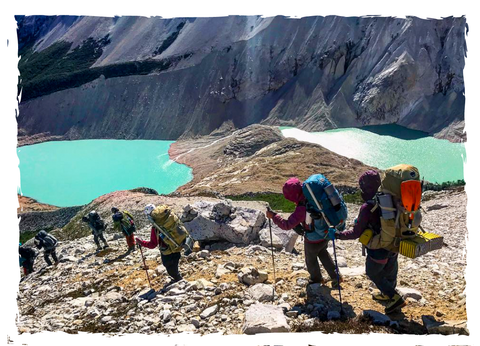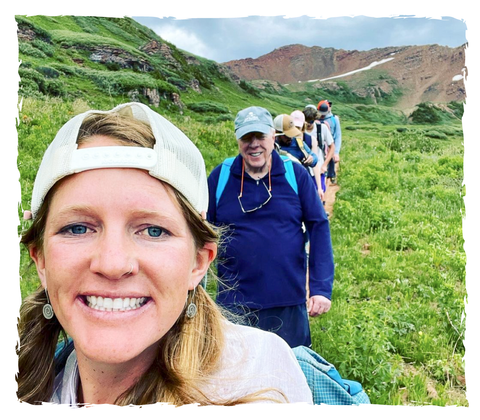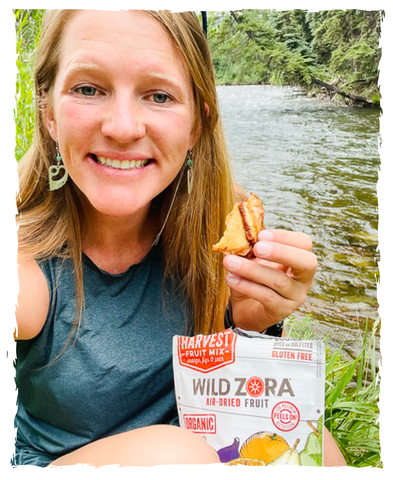How to Plan For an Outdoor Adventure

I’ve spent more nights sleeping in a tent than I could possibly ever count – and for that I am so grateful. Sleeping outdoors, under the stars, beats a roof any day of the year for me. It really doesn’t matter whether I am, next to a silty and roaring desert river, hunkered down among the rocks with the wind blasting me on a Patagonian peak, watching the sun make endless circles over the Antarctic ice field, or just lying under the cottonwoods in my backyard in Colorado. I will choose outside every single time.
I work as a mountain guide and river guide because my life mission is to help other people experience the serenity of nature and the strength we all can find in the wilderness. So, although dear reader, you may not be on the other end of my climbing rope (although we could arrange that if you want), or in my raft slipping through the deep canyons of the desert, let me see if I can’t help you get outside too.
They say that mentors are one of the biggest obstacles to people getting outdoors. After all, how do you begin? I am here to give you a crash course (and I mean really abbreviated in the grand scheme of things) on how to begin.
Personally, I start by dreaming up a place I want to go. Mountain lake? Canyon country? Rolling plains? Then I hop onto my computer and search for a place that looks appealing (and accessible to me).
As soon as I have a destination in mind, I get to planning.

Some key questions to consider (and answer!) before you walk out your door:
- Are you fit enough for this adventure, or do you need to train?
- Give yourself an honest assessment because otherwise you might get into trouble out there.
- Will you go alone or with other people?
- Either way you need to be sure to let someone know exactly where you are going and when you will be back. “Check in and out” with them. If you think this is silly just watch the movie “127 Hours.”
- What kind of conditions will you encounter?
- Snow? Heat? Rugged terrain? Answering this will help determine the gear you will need.
- ** Pro tip – you can always call the ranger station for the area you are interested in going and ask them if there is any pertinent info you need to know. Things like trail conditions, bear activity, water supply, wildfires, are permits necessary etc.
- How long do you anticipate the adventure to take? If you are walking, people generally move 3 mph with breaks. I like to walk for 50 minutes and then take a 10-minute water and snack break. Also, 1,000’ of elevation gain usually takes the same amount of time as one mile. Calculate out your time taking your own fitness level and experience into consideration.
- How many meals will you need? I like two snacks during the day but more on this later.
- What is the weather forecast?
- What is your timing plan? This includes deciding what time you will turn around if you have not yet made your destination. People get what we call “summit fever” and make dumb (or life threatening) decisions trying to complete their goal. This, in my opinion is silly. The “summit” will always be there, and you can return. However, you cannot return if you are struck by lightning above tree line because you didn’t turn around in time. So, be smart, be humble, have a plan, and stick to it.

Once you’ve got those things answered, you’re ready to start packing. This is both an exciting, and crucial step.
In general, this is the basic gear I typically take with me:
- Backpack
- Water and filtration/purification system
- 1st Aid Kit – any medications you might need and blister care are a must
- Food
- Headlamp (always!!)
- Communication device
- InReach makes a very light and easy to use device that I like a lot
- Appropriate walking shoes
- Don’t wear new shoes on a big hike. A blister would likely ruin your day.
- Change of socks
- If your feet get wet they are more likely to blister, so I change my socks when I need to.
- Base layers
- Merino wool works great for this
- Shorts
- T-shirt
- Vest
- My all-time favorite layer. I don’t go anywhere without it.
- Light fleece
- Rain jacket (always!)
- Sun Hat
- Sunglasses
- Sunscreen
- Chapstick
- Navigational tools
- Even if you think you know where you are going take a gps, map, compass etc. You don’t need to go crazy at REI or your local gear store but you do need to know how to read a map and should generally have one with you. People get lost. This is a fact.
- Kula Cloth (for peeing) plus TP and zip lock for trash (for our other needs…)
- Ladies, if you haven’t heard of the Kula Cloth I suggest you stop everything you are doing and go look them up. Antimicrobial, water resistant, cute and very handy for staying clean and dry in the backcountry.
- Hiking Poles
- Buff
- Works as a headband, sun protection, or a mask
- Phone
- Fully charged for photos or to use in case of an emergency
- Emergency shelter or tarp
- Even a big black trash bag would work in a pinch
The key to dressing yourself is to have a number of versatile and light layers. When you put all of them on, you’ll be warm. You also need to make sure you can stay dry. Getting wet can be very dangerous in the back country. No cotton is a pretty firm rule. We backcountry guides call it “killer cotton” because whether it is rain or sweat, it will suck your body heat and make you cold. That’s bad. So, invest in some wool (which I like because it doesn’t get as smelly), or quick dry material.
Finally, give all your gear a test run before taking it out on a big mission. It’s the worst when you discover your backpack rubs your shoulders raw, or you have no idea how your water system works. Test everything beforehand. Lastly, I make a packing list every time I go out. I’ve packed my bag literally thousands of times, but I still make a list and check it. I prefer the tedium of a list than arriving at the trailhead and finding out that I forgot my hiking boots or socks. No bueno. I also like to take notes each trip so that I know what worked well and what I need to adjust for next time. That way I can refine my systems.
Once you’re dialed you’ll be stoked. Even dialed, I encourage the list.

On to our final topic, food. The thing we’ve all been waiting for. Afterall, food is probably what landed you on this blog in the first place, so let’s get to the subject we all really want to talk about anyway.
How do we nourish ourselves in the wilderness?
That’s the real question. Not, how do we feed ourselves. We are not just trying to shovel in the right amount of calories and move on – if we were we would be pounding protein shakes, with ingredients we can’t even pronounce, and call it good. My guess is you are here because you don’t want to go the protein shake route, or you have been doing the protein shake route and want something different. Welcome all! We are here because we want to nourish ourselves, treat our tastebuds well, fuel our adventure, and feel good.
Luckily Wild Zora has made that easy for us. I know this is where you think, “Yeah yeah now she is just going to sell this product to us.” But I am serious. I have been on and off again paleo since college more than ten years ago and usually I go off it because I am spending so much time in the backcountry, and I couldn’t get the food I needed to make it work. I feel best when I don’t eat grains, dairy, or things loaded with sugar and, if you take a look at most snacks or back country foods on the shelf, you will be hard pressed to find something that fits those criteria. I was always crashing when I was out climbing or boating. I would eat a snickers bar, feel jazzed for about an hour, and then be hangry and exhausted. I found some things that worked for me, like nuts and jerky, but I just wasn’t getting the nourishment I needed. Enter Wild Zora. I love the balance of Wild Zora foods and the variety. There are breakfasts, snacks, dinners, and everything in between.
Typically, I eat breakfast, morning snack, lunch, afternoon snack, and dinner. I try not to stray too far from my normal eating habits because if I do my tummy will be upset and, if you are out there for very long, it will make it hard to poop. Yep. I did just say that. It’s a reality. Wild Zora fortunately includes lots of veggies and fibers in their meals, so it makes it easier. Anyway, back to planning what meals I take and make.
If you like sweet breakfasts at home, then bring a sweet breakfast and if you do savory bring savory. There isn’t a need to totally revamp your diet just to be in the back country. I like littler breakfasts because I don’t want to waste time in camp, nor do I want to start the day really full and feeling sluggish. A bowl of oatmeal and some dried fruit (or fresh if you can handle the weight) is the way to go in my opinion. And coffee. Don’t forget the coffee, or tea if that’s your jam. I either take my AeroPress or Starbucks instant coffee.
For morning snack, I like sweet things like dried fruit, fruit leather, unsalted nuts etc. Often times I make my own little GORP bag with almonds, craisins (I like the ones sweetened by apple juice) and dark chocolate chips). Easy peasy. Keep it quick and simple.
I never particularly want to take the time to cook lunch so I like to bring things like carrots or celery, almond butter, apples or oranges, hard salami, hard cheeses if that’s your thing, dark chocolate… hardy food items that will last and that are fresh. I am all about sneaking as many vegetables into an outing as possible because I know in the long run, I am going to feel way better for it than if I just eat packaged and processed food, even good packaged food. Also, if you bring a nut butter, I recommend bringing only the portion you will eat and not a whole jar. Those suckers can be heavy.
In the afternoon I am typically ready for a salty snack. I’ve been sweating and need to replenish some of those salts in my body and I can feel that. I would recommend a meat & veggie bar or… dare I say? Chips! I love chips. I look for ones that are kettle cooked and have avocado or olive oil but I love me some chips. They are salty, and crunchy, and entirely satisfying mid-afternoon. Plus, at that point I really feel like I’ve earned it and the calories are more than welcome to keep me rolling. I never count calories but I do pay attention to getting enough calories. People make the mistake of not eating enough when they are in the wilderness and it is a safety concern if you are crashing because you are hungry. It can even be hazardous if it is cold, and your body is trying to heat itself but doesn’t have enough fuel to burn. I caution you to not underfeed yourself when you are out, and I encourage you to definitely be eating salt. Our bodies need salt and I think our culture has scared us away from it (with reason in some settings) but when you are outside and working hard you need it. So, pack those chips and enjoy every bit of them. You’ve earned it. 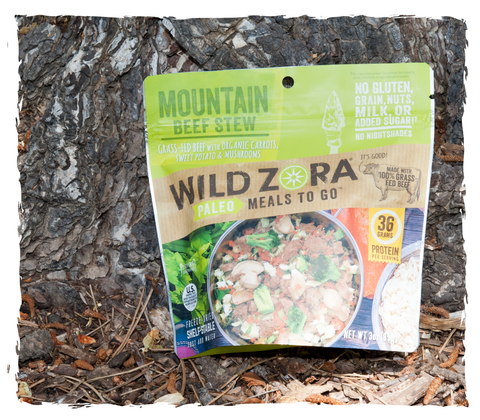
Finally, dinners. I love the Wild Zora dinners. Especially the Mountain Beef Stew. Two days ago, I finished rock climbing at 9:30 PM, I was starving and starting to feel very grouchy about it. I could tell that my climbing partner was giving me a wide berth and I don’t at all blame her. We all know that roaring dragon when it comes to visit, right? Right?? Tell me I am not the only person who gets hangry. At any rate, I had guided all day and desperately needed to refuel. Within ten minutes of getting back to my camp I had boiled water and my stew was soaking. I always carry spices with me and on this occasion, I added nutritional yeast, hatch green chili powder, Crazy Jane’s salt, and a little ghee to the mix and it was utterly heavenly. I think I downed it in under five minutes. I often like to carry broccoli with me too and add that into the pot (or in this case bag) as well. I love the crunch and again… greens. Most people discard the broccoli stem but I eat those as my appetizer. You just cut it up into little disks, and they are wee broccoli chips and super yummy. I then toss the head into my meal and voila! I have made my meal fancy. I generally have spicy powder on me, either the hatch green chili or chipotle chili powder, salt mix, cumin, garlic powder, and nutritional yeast. With that combo you could make an old shoe taste good. If you haven’t tried nutritional yeast, I recommend it. It’s cheesy and gives you good vitamins and minerals that we all need.
I like finishing my day with a cup of tea as the signal to my body that we are now done and to let my brain know it is time to relax. I don’t do anything with caffeine in it, and I typically don’t want to carry honey with me because the thought of having it explode in my backpack makes me cringe (I really hate sticky things), so I look for something that satisfies the craving for dessert, and also lets me sleep. Stash makes a delicious tea called “Licorice Spice” that is sweet all on its own and usually that’s my beverage of choice.
Phew. That was a lot on food, packing, and general know-how and yet I barely scratched the surface. Just know that you will always be learning things about being in the backcountry or even out on a casual jaunt through town. Feel free to reach out if you have questions or are planning a trip and want to run any ideas by me. I am so excited for you and the adventures awaiting you!
With so much love!


 |
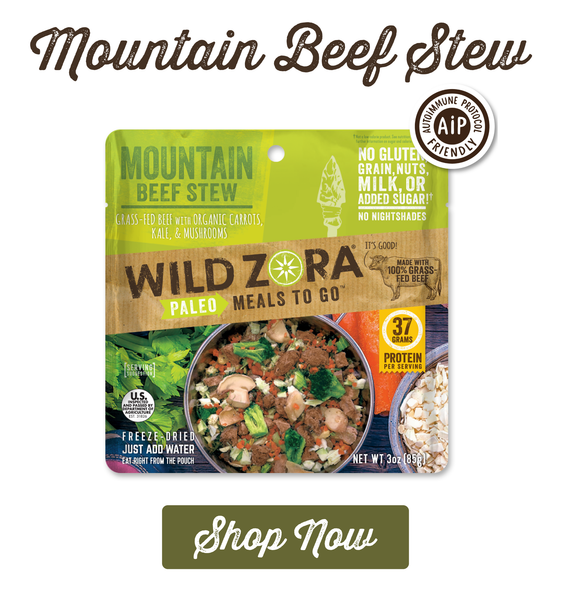 |
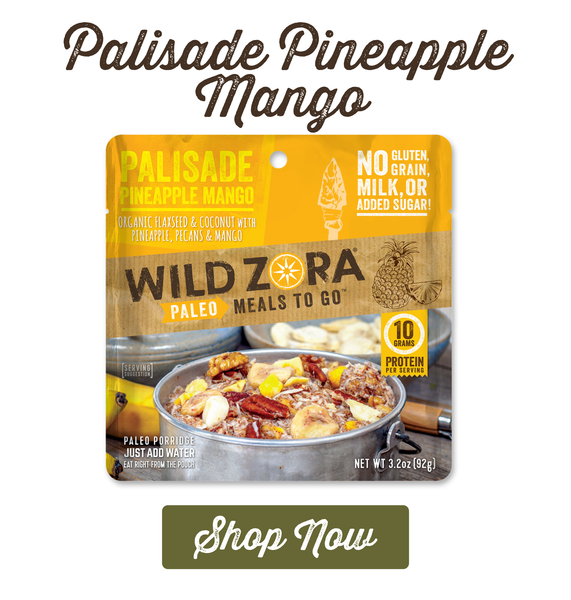 |
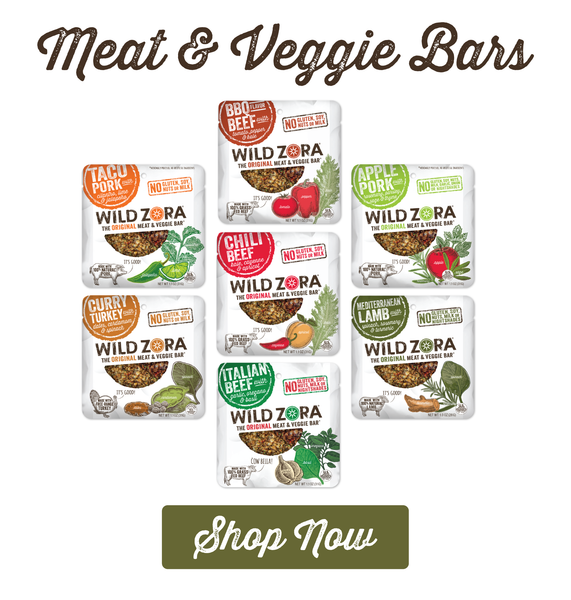 |






